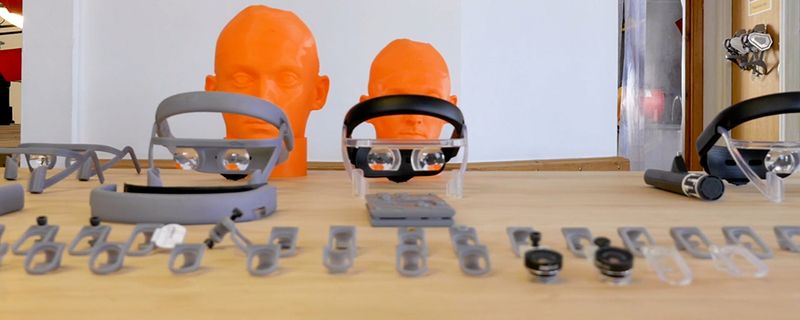Watch the full interview
The journey...
Grace Vassallo:
What was it that made you want to be a part of the Zapbox journey when Zappar approached you?
Steven Spong:
The move away from screen-based interactions with digital content is kind of a given. There's been a lot of sort of prophesizing and people putting dates on wide-scale adoption of VR and AR for a number of years now. They've been a little bit ambitious, to say the least.
It was just really exciting to see a company that is actually looking to put it out there and to democratize it, to put it in the hands of as many people as possible. What we're doing here, it's sort of baby steps, but ultimately, that's the way that it's going to happen. The more people that you've got looking at this stuff, the better content you're going to have made for it. Then yeah, that movement will start. In terms of AR and MR in general, the projects that we like to get involved with are around health and wellbeing and movement. Yeah, very excited about what MR, in particular, has to offer in that regard to move away from screens and start interacting with digital content in sort of more dynamic ways, moving, standing up, and getting out of your office chair or away from a gaming station, or something like that.
Grace Vassallo:
So for you, what is it that makes all-new Zapbox different?
Steven Spong:
The first iteration was very much based around Google Cardboard. What they were doing was pretty fantastic in terms of getting VR into the hands of as many people as possible. What we found with using it for mixed reality purposes was the fact that there's a bit of a barrier there to adoption in terms of people putting on the headsets and feeling more closed off from their environment. They're feeling vulnerable. They're not feeling connected with the people around them if they're trying to do something socially or they're trying to share an experience on a game or something like that.
Then there's the problems with banging into things if you're moving around. So it was always going to be a move to try and remove as much of this peripheral as possible. The big step has been in trimming away what you'd usually have on a headset, which is a sort of shielding. For mixed reality, it's not really that relevant. We want to see a peripheral, we want to interact with people around us and we want to feel more engaged with the environment that's right in front of us.
The whole movement has been around essentially just removing as much of the headset as possible and just leaving the digital content there, being careful about putting the right tints on lenses, just to ensure that the digital content is viewed at kind of the same light levels as you're seeing in your peripheral.
Most other mixed reality headsets, especially those that are using the reflective screens, you get a lot of ghosting, you can't really use them in high-level light conditions. This headset provides something that with video see-through you're able to use in all lighting conditions. You can see your peripheral vision as well as the digital content in front of you. So that's the main move, it's delivering the video see-through mixed reality content, but blending it with a peripheral, that's what we've aimed for.
The materials...
Grace Vassallo:
Is it the move from cardboard to plastic that really helps remove that shifting?
Steven Spong:
Yeah, absolutely. I mean, we always wanted to take into consideration the environmental impacts of the materials that we're using, and in order to justify and move away from cardboard, we had to do it if we wanted these clear elements and to have the level of comfort that we've got in this new headset. So yeah, it was a difficult decision to make, but ultimately we're including as much recycled content as possible with the plastics. All of the elements will be recyclable in the main headset unit as well. So it was a necessary step in order to get the functionality and utility that we're getting here because we're delivering a lot for not a lot in return really.
Grace Vassallo:
We've dealt with the materials, in terms of the visual the controllers have changed a little bit since the last iteration, is there anything you can tell us about that?
Steven Spong:
The original controllers almost look like maracas. They were pretty big sort of code diamonds on the end of these sort of cardboard holders. What we found within the experiences was that that was actually protruding and you could still see quite a bit of that when you're using the content and using the controllers. So we trimmed those back as much as possible, and took away that diamond from the top. Essentially it was all based on these visual recognition algorithms and improvements in that area rather really than the hardware. So we've just been able to accommodate that with a more durable form factor. Yeah, I think it's looking and working really well.
The design approach...
Grace Vassallo:
How do you think this kind of new design, and all-new Zapbox is important to the future of mixed reality?
Steven Spong:
The reason why we think this is important, is we've delivered a lot using as few materials as possible. We're keeping the price point as accessible as possible. So it's going to get out there into the hands of as many people as we can get it out into, and it's important in respect to the fact that there's a lot of people out there that have never experienced it. What we're hoping is that this can be sort of an entry point for a lot of people into mixed reality and then also an entry point into making content. So using the suite of tools that's available in order to enjoy the mixed reality experience and make use of it.
Grace Vassallo:
How would you describe your design approach for all-new Zapbox?
Steven Spong:
A phrase that kept on coming up was, "Super simple solutions." So everything that we came to, we were looking at, okay, how can we get the most utility out of as few materials as possible? So if we've got one part, if we've got one molded part, how many jobs can we make that part do? You're going to see the sort of the glasses element on this, the arms on them. We used the tensile strength and the flexibility of certain materials to do things that usually you'd see done mechanically in other products that are out there on the market.
I think that one of the reasons why we're able to do that was because of our prototyping methodology. We go all the way from concept to completion. So we'll start with conversations and sort of throwing around ideas. Then it's an iterative process between sketching in CAD, computer-aided design. Then it's an iterative and back and forth between CAD and actually printing things out using SLA 3D printing. If we're CADing things up during the day, put it on the printer overnight, and then when you get in in the morning, there's a new prototype there for us to test and iterate and improve on every time.
The components...
Grace Vassallo:
As I can see, there's quite a few different components to all-new Zapbox. Can you take us through them?
Steven Spong:
So we'll start with the headband. We took inspiration from welding helmets. So people that are welding are using their face shields all day, they need to be super comfortable. So we took the inspiration for the angle and the strapping, and the padding from that. Then in order to accommodate for different forehead types and the like, we've got these sliding sections at the side, which bring the lenses the appropriate distance from the eyes and make sure that it's comfortable for all. So it's actually almost sort of self-adjusting in that regard. It also means that you can pull the glasses element away from you if you want to talk to other people in the room as well.
Grace Vassallo:
So will the adjustable elements help me wear this with my glasses that already sit on my face?
Steven Spong:
Exactly. So yeah, you can use this if you already wear glasses or not. We've used polypropylene for the elastic that we need to be really confident and people need to be really confident that their friends can be safe when it's in there. So it's held not only sort of front to back but also side to side. Then at the front here, we've got the lenses that have been clipped in order to trim the usual sort of bevel of the phone, to blend the digital with the physical as seamlessly as possible. Then also we've been able to accommodate for different interpupillary distances with a sort of clip-in lens section at the front too.
We've got the ratchet at the back that racks in and out. We've put a universal wide-angle lens adapter to use here. We've got two clips, one for phone cameras that sit a little bit further on your phone, and this little diddy one for ones that sit on the corner. So yeah, this wide-angle lens will just pop over the top of your camera and that allows you to see a little bit more and more equally balances what you're seeing on a digital readout with your peripheral vision as well.
Grace Vassallo:
So we spoke briefly about the evolution of the new controllers. Can we know a bit more about the new ones?
Steven Spong:
The controllers have been trimmed down more so than the previous controllers that had a sort of diamond configuration on the top. This is a bit more discreet. Your hand covers up this element obviously, and then whatever the digital content is, whatever you're supposed to be holding can sort of cover up the rest of it.
Grace Vassallo:
So I have to ask in terms of challenges and highlights of the project so far, what have they been?
Steven Spong:
The innovative process, coming up with the trimmed lenses. The very early stage is all quite euphoric because you've overcome these problems and it all moves very, very fast. But when you dial into the details, it is challenging. So there's been lots that we've iterated on here. We've gone through hundreds of prototypes over a long period of time in order to refine the headset to what it is today. Certainly, some of the challenges were mostly around safety, but the safety of people's phones going in and then also the economics around us making sure that we're delivering something that although it's a lower price point, it's super comfortable for as many people as possible. So yeah, those are the challenges and I think overcame them well.
Grace Vassallo:
Thank you so much for talking to us about all-new Zapbox.
Steven Spong:
No problem. Nice speaking to you.
 Grace Vassallo
Grace VassalloSenior Brand & Marketing Manager, Zappar

